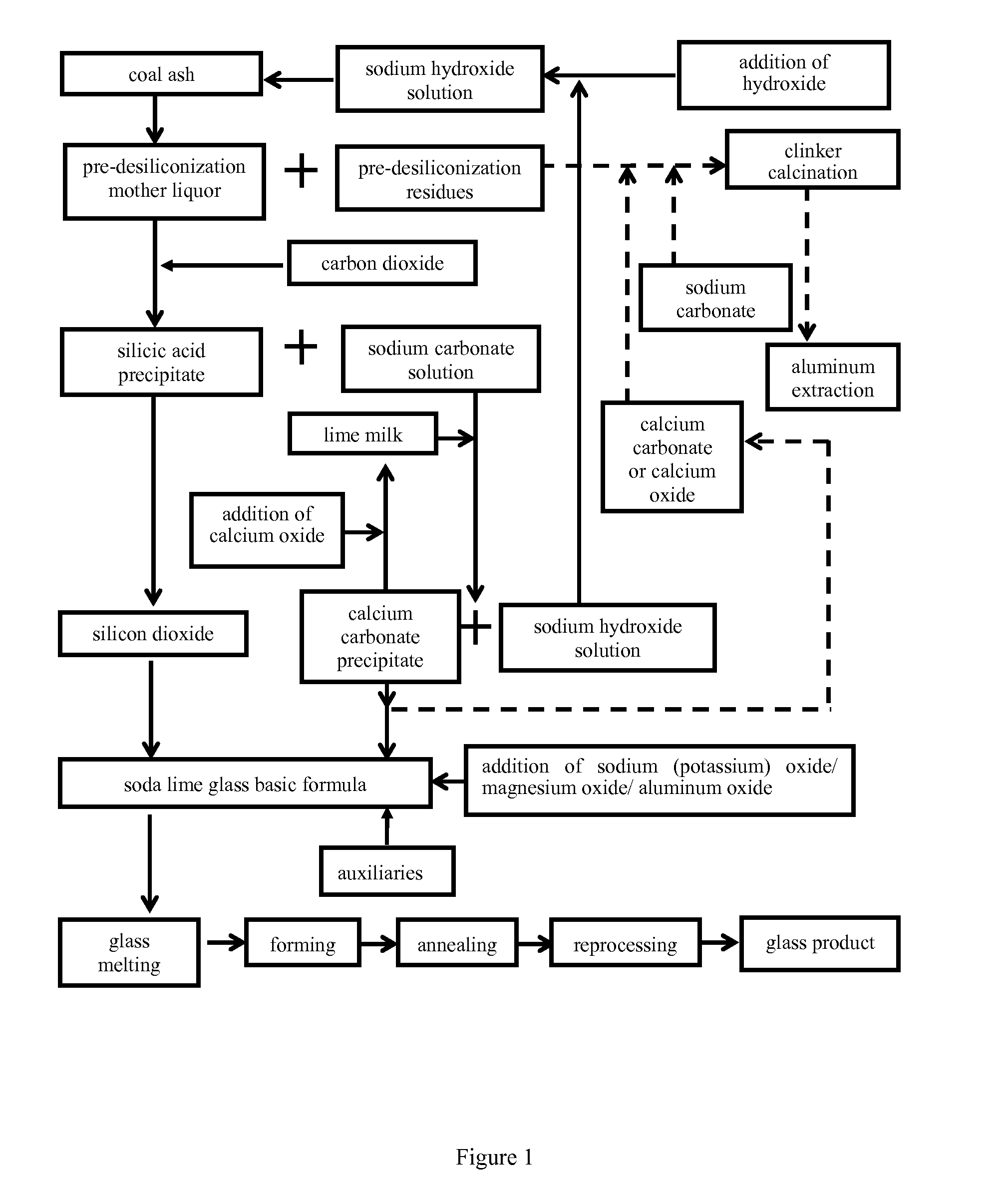Method for Preparing a Soda-Lime-Silica Glass Basic Formulation and a Method for Extracting Aluminum from Coal Ash for Co-Production of Glass
- Summary
- Abstract
- Description
- Claims
- Application Information
AI Technical Summary
Benefits of technology
Problems solved by technology
Method used
Image
Examples
example 1
[0062]1000 g coal ash with above composition were reacted for 3 h under stirring under the condition of: a NaOH solution concentration of 20%, a mass ratio of ash to alkali of 1:0.6, and a reaction temperature of 120° C. Upon filtering and washing, a pre-desiliconization mother liquor and coal ash residues were obtained. The pre-desiliconization mother liquor mainly consisted of sodium silicate and sodium aluminate, and had a mass ratio of SiO2 / Al2O3 of 65.23. The pre-desiliconized coal ash residues, which were subjected to hot-air drying under a temperature of 120° C. for 3 h, weighed 820.5 g, the chemical composition of which was shown in Table 2 (wt %). Thus, the amount of Al2O3 in the coal ash residues increased from 50.71% to 60.13%, the mass ratio of Al2O3 / SiO2 increased from 1.27 to 2.25, and the extraction rate of SiO2 was 42.5%.
TABLE 2IgnitionTotalSiO2Al2O3Fe2O3FeOMgOCaONa2OK2OH2OTiO2P2O5MnOlossSamount26.8160.131.810.410.553.310.950.60.111.810.210.0311.530.2598.51
[0063]Carb...
example 2
[0067]The stages of obtaining coal ash residues by pre-desiliconization, and the preparation of silicon dioxide and calcium carbonate were completely same as those in Example 1.
[0068]All of the obtained coal ash residues were used, and the dried calcium carbonate precipitate was used, according to a molar ratio of [CaO] / ([SiO2]+0.5[TiO2]) of 2, added with sufficient amount of calcium carbonate, and added with sodium carbonate according to a molar ratio of [Na2O] / ([Al2O3]+[Fe2O3]) of 1, mixed uniformly, and calcined under a temperature of 1200° C. for 3 h to give clinker. A formulation liquid was prepared, comprising 15 g / L Na2Ok (caustic alkali) and 5 g / L Na2Oc (alkali carbonate). The formulation fluid was withdrawn according to a liquid-solid ratio of 10:1, heated to 85° C., after adding therein said clinker, stirred and leached for 15 min, filtered to obtain a leaching liquid, followed by introducing therein carbon dioxide until the pH reached 8.5, to give an aluminum hydroxide pr...
example 3
[0069]The stages of obtaining coal ash residues by pre-desiliconization, and the preparation of silicon dioxide and calcium carbonate were completely same as those in Example 1.
[0070]All of the obtained coal ash residues were used, and the dried calcium carbonate precipitate was used, according to a molar ratio of [CaO] / ([SiO2]+[TiO2]) of 1, added with sufficient amount of calcium carbonate, and added with sodium carbonate according to a molar ratio of [Na2O] / ([Al2O3]+[Fe2O3]+[SiO2]) of 1, mixed uniformly, and calcined under a temperature of 1050° C. for 2 h to give clinker. A formulation liquid was prepared, comprising 15 g / L Na2Ok and 5 g / L Na2Oc. The formulation fluid was withdrawn according to a liquid-solid ratio of 10:1, heated to 85° C., after adding therein said clinker, stirred and leached for 15 min, filtered to obtain a leaching liquid, followed by introducing therein carbon dioxide until the pH reached 8.3, to give an aluminum hydroxide precipitate. The aluminum hydroxid...
PUM
| Property | Measurement | Unit |
|---|---|---|
| Temperature | aaaaa | aaaaa |
| Temperature | aaaaa | aaaaa |
| Temperature | aaaaa | aaaaa |
Abstract
Description
Claims
Application Information
 Login to View More
Login to View More - R&D
- Intellectual Property
- Life Sciences
- Materials
- Tech Scout
- Unparalleled Data Quality
- Higher Quality Content
- 60% Fewer Hallucinations
Browse by: Latest US Patents, China's latest patents, Technical Efficacy Thesaurus, Application Domain, Technology Topic, Popular Technical Reports.
© 2025 PatSnap. All rights reserved.Legal|Privacy policy|Modern Slavery Act Transparency Statement|Sitemap|About US| Contact US: help@patsnap.com


